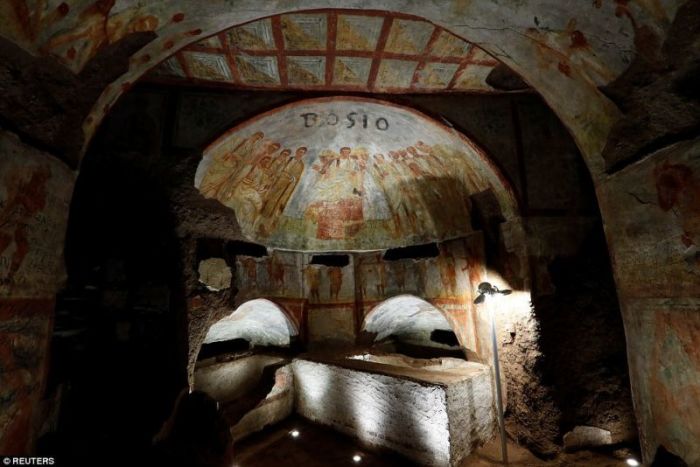1,600-Y-O Christian Frescoes Unveiled in Roman Catacomb Reveal Move From Paganism to Jesus

Renovation work has unveiled 1,600-year-old frescoes in Rome's biggest catacomb, featuring "stunning" depictions of the stories from the Bible, and shedding clues on how Romans moved from paganism to following Jesus Christ.
The MailOnline reported that laser technology was used to remove the grime from the frescoes, which had been hidden under centuries of dirt.
The renovations at the Domitilla catacombs, which depict both pagan and Christian paintings, reportedly sheds light into how Romans moved away from pagan beliefs and toward Jesus Christ in the fourth century A.D.
The catacombs stretch 7.4 miles and consist of 26,250 tombs, with some of the crypts depicting major scenes from both the Old and New Testaments, such as Noah's Ark, Daniel in the den of lions, and Jesus feeding the 5,000 with bread and fishes.
Christ is also depicted with some of his disciples, believed to be either Peter and Paul, or Nereus and Achilleus.
Some of the pagan frescoes reportedly include paintings of peacocks, which are a sign of the afterlife.
"These tombs represent the roots of our deepest identity, the roots of Rome and of Christianity," said Cardinal Gianfranco Ravasi, head of the pontifical commission, at a news conference on Tuesday.
As Phys.org reports, beside major religious scenes, the frescoes also include slices of daily life, such as bakers making bread. Experts noted that is not coincidental, as bread has great symbolism in both Christian and pagan traditions.
"These works show the difficult path the Romans walked on the way to their new faith," said Monsignor Giovanni Carru of the Pontifical Commission of Sacred Art.
Laser instruments had to be used to successfully peel away the thick layers of algae, calcium deposits and smoke stains from oil lamps that had covered the the paintings, with organizers hoping a museum will be open to the public by the end of June.
They warned that it could take a number of months before all the restored areas are available, however, but much of the vast archaeological site is expected to be open to visitors this summer.
Sarah E. Bond, an assistant professor of classics at the University of Iowa, wrote in an article for Forbes.com that restoring the frescoes adds value "in analyzing the themes, ideas, and people of the ancient world."
"Hundreds of bones and epitaphs were torn out of the catacombs and exported all over the globe in the middle ages and the Renaissance — often sold as relics to churches throughout Europe," Bond wrote.
"These frescoes remain in the spot they were first painted and their restoration puts the late antique world into context and technicolor for us. Oh, and they also put a few rogue archaeologists on notice 400 years after the fact," she added.




























